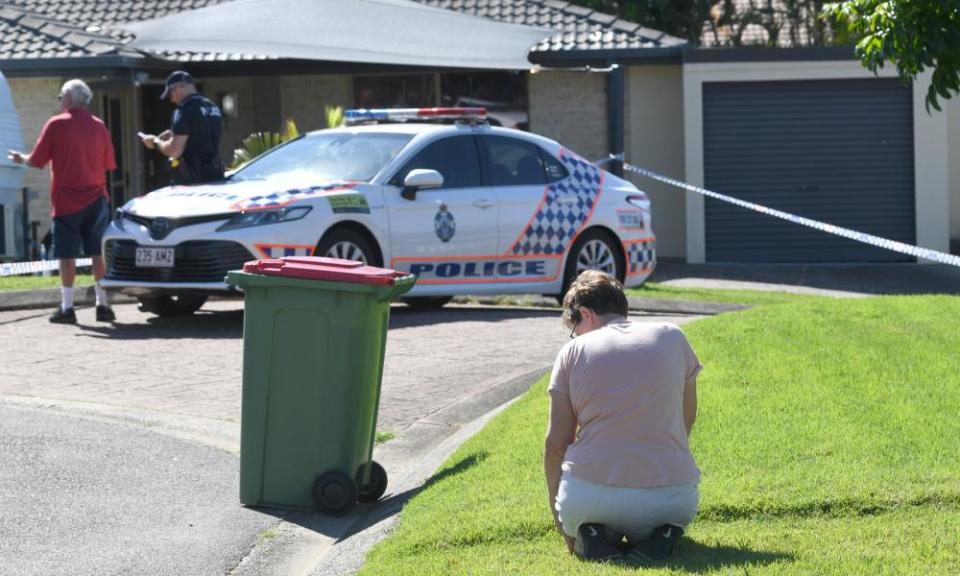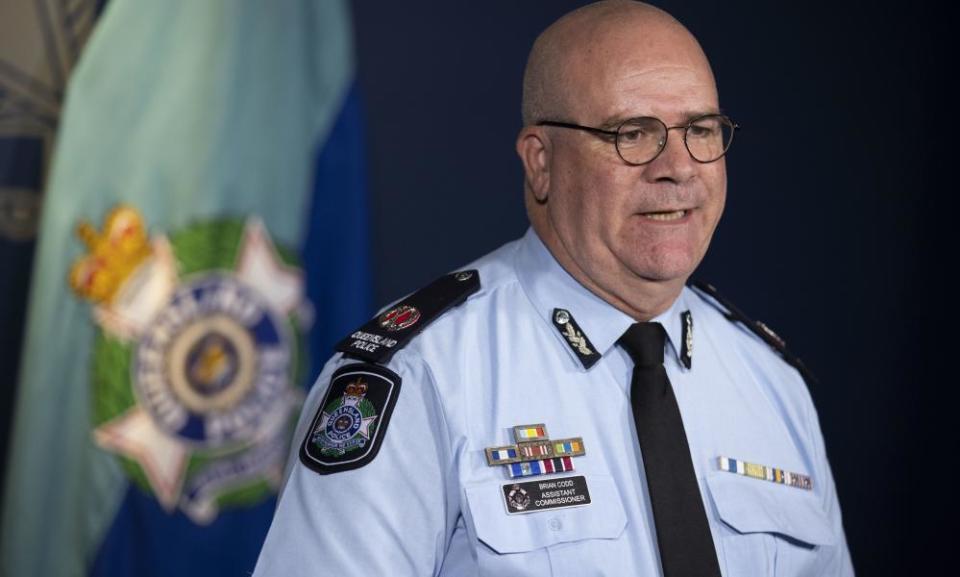‘A very broken system’: why are Queensland police still getting domestic violence cases so wrong?

Six months before she was murdered, Noelene Beutel was beaten within an inch of her life; beaten so badly she ended up in hospital, her teeth cracked and her face covered in bruises.
Two Queensland police officers came to the hospital to take a statement, but Noelene wouldn’t speak to them. She was antagonistic – a response borne of fear and distress. At the same time her attacker was at home, looking after their infant daughter.
So the police turned and left. According to the state coroner they “responded poorly … and wrote off the job”.
Beutel was murdered by her partner a decade ago next month. Every time another woman is killed in Queensland, her family relives the same sense of futility – that the more promises are made things will finally change, the more they stay the same.
Related: Queensland police misidentified women murdered by husbands as perpetrators of domestic violence
“You sort of think that you’ll get over it and you never do,” her sister, Rhonda Ziebell, told Guardian Australia this week.
“Now I watch the news and see families [of domestic violence victims] say they had called the police begging, saying ‘he’s going to kill us’.
“I do get frustrated. There’s always another one. Every time we relive it because there’s another family going through what we are going through.”
Thumbing through Queensland coroner’s reports from the past decade, there are plenty of blunt warnings to police that highlight problematic responses to domestic violence victims. They include the inquest into the 2011 killings of Antony Way, Tania Simpson and her daughter Kyla, which detailed how a police officer did not consider the killer’s prior controlling behaviour to be domestic violence.
The inquest into the death of Mr M – killed by his partner’s ex – described the police response as “inadequate” and beset by “inaction and tardiness”. The report on the death of Indigenous woman Elsie Robertson in 2013 outlined what police themselves concluded was “an unreasonable delay” of more than an hour between a call for assistance and officers attending the address in Cairns.
A common thread in many of these reports is the response by police to scrutiny and outright criticism about their responses to domestic violence. They have repeatedly committed to reform, to better educate officers and to review policies and procedures.
Twice this year, women in Queensland have been killed in circumstances where they had repeatedly sought police help. The deaths of Doreen Langham and Kelly Wilkinson have come with further admissions of police and system failure. So why – after all the red flags and all the promises to do better – are authorities still getting these cases so wrong?
Uncomfortable conversations
Assistant commissioner Brian Codd, the Queensland police officer with oversight of domestic and family violence, agreed to be interviewed by the Guardian last week.
His willingness to talk about police culture and attitudes to domestic violence victims is something of a surprise. More than a dozen prior requests over three years, including to two separate commissioners, have all been politely declined by the Queensland police service’s media unit.
“We’ve got to be open to some uncomfortable conversations,” Codd says.
“We might not [always] get it right. And I’d suggest there are a number of occasions where we don’t get it right. But we’re keen for a conversation. Perhaps we’re a little late to the table. I think not, there’s lots of things been going on in the background.”
During a 90-minute conversation, Codd treads a careful path between acknowledging that police practices require new approaches and impetus for change, and rejecting outright that police culture and attitudes are a widespread problem.
“I accept that there’s some less than appropriate responses that are given. I’m suggesting to you from on the inside, I see every day examples of the contrary. We’re striving continually to get that right.
“We expect an enormous lot of our frontline officers at 2.30 in the morning when no one else is around [but] I know we can do better. We’ve got to do better.”

The conversation with Codd eventually reaches what feels like the key question. How can any woman experiencing domestic violence in Queensland trust police to keep her safe?
The question is, of course, heavily loaded. Guardian Australia cites several cases that have previously exposed problematic attitudes by police towards domestic violence victims. There is Julie*, whose address was accessed by an officer and leaked to her violent former partner.
Dani* privately prosecuted her former partner, who poured petrol on her, when police refused to bring charges. Lyla’s rape statement was placed in a shredder.
In 2017, almost half the women killed by their intimate partners in Queensland were labelled by police as perpetrators of domestic violence, and a subsequent study found police continue to misidentify victims – that police often fail to view individual incidents in context; that some police use “gut feeling” or body language to decide which partner should be made subject to a protection order.
At last count there were 84 police subject to domestic violence allegations and a recent “concerning increase” in those numbers.
Private police Facebook pages reveal problematic attitudes in the ranks. One victim told University of Queensland researchers that police “suggested I try going to a different police station”.
And then there are Wilkinson and Langham, who both repeatedly contacted police seeking help to keep them safe before they were killed.
How can a woman feel confident reaching out to the Queensland police?
“I’m incredibly loath to perpetuate a perception that if [a woman] goes to a police station she won’t be listened to,” Codd says.
“The dangers of dissuading people from reaching out … the dangers are greater by not reaching out than perhaps having an interaction with that small cohort that might not be as sympathetic and compassionate as they might be.
“How do we counter that? With reality. I don’t discount for a moment that there are people telling frontline service providers that’s why they don’t go to police. We’ve got to somehow turn that feeling around so they can have the confidence. I know of scenarios where tens of thousands of people who do engage with us [are treated well].”
‘Police accept the male’s version’
Codd has been made head of a new command with oversight of domestic and family violence and is actively looking at new approaches, including better integrating responses with support services and potentially employing more specialist police. Currently there are just 86 domestic violence specialists among 12,000 frontline officers and only 20 working on high-risk teams, which is the core measure in Queensland to assist women considered the most vulnerable to harm.
Police have also expressed an interest in the work of the Queensland University of Technology criminologist Kerry Carrington, who advocates victim-centric police stations for women and families, based on a successful model from Argentina.
While that new impetus for some reform has been welcomed, there are already concerns among experts and women’s advocates that police are resisting the need to look too deeply within, when evidence that police culture contributes to failings is clear and longstanding.
Related: Queensland police blocked research into domestic violence cases and attitudes of officers
One senior serving police officer told Guardian Australia: “Lots [of police] want to be law enforcement, to catch bad guys. They think domestic violence is dangerous social work, until such time as a woman gets very badly hurt.”
Research by Australia’s National Research Organisation for Women’s Safety last year into the misidentification of victims found “racism, poor relationships with local communities, misogyny, and the patriarchal culture of the police service” were ongoing concerns.
Those problems also disproportionately affect First Nations women.
“In multiple cases, the primary perpetrator is a non-Indigenous male,” says Cathy Pereira, the principal solicitor of Aboriginal and Torres Strait Islander Women’s Legal Services North Queensland.
“On police arriving, he is calm and gives an account to police which is coherent. The Aboriginal and Torres Strait Islander woman is highly distressed – in some cases she has been the victim of life-threatening assaults or repeated emotional abuse. Police accept the male’s version. He is more coherent and it is easier to record.”
A repeated pattern
The Queensland government points to a number of domestic violence reforms implemented since the Not Now, Not Ever report in 2015, and is awaiting a report by a taskforce looking at issues including the criminalisation of coercive control.
But Angela Lynch from the Women’s Legal Service Queensland and others say the response to domestic abuse has always lacked the sort of urgency and rhetoric used in the recent government and police crackdown on teenage car thieves.
“There’s a level of acceptance of violence against women as normal,” Lynch says. “It reflects a level of contentment with the status quo and that’s concerning.”
In discussions with non-government organisations involved in some of Queensland’s high-risk teams, support workers all say the programs simply need more funding; that the concept is sound but that resources mean they see a fraction of the women who need help.
Related: Coercive control laws could harm vulnerable women, advocates in Queensland warn
On the Gold Coast, the group Hearts of Purple was set up after the death of Teresa Bradford and arranges security measures for women at risk, including watches that can sound alerts and contact emergency services. They help raise money for their work by recycling bottles and cans, for 10c a piece.
“It’s a very broken system, in terms of collaboration [between support services], education, training and funding,” the Hearts of Purple chief executive, Michelle Beattie, told Guardian Australia.
“The hardest thing is we can’t help everyone [who seeks assistance]. If we had funding we could do that.”
Survivors and the families of victims feel that same sense that the systemic response to domestic violence needs more than a few dollars and a few tweaks.
A decade on, Noelene Beutel’s family cannot work out how the situation in Queensland and across the country seems to be worsening.
“We watch all those stories all the time and it’s a recognised pattern of these blokes. It’s a repeated pattern, a very recognisable repeated pattern,” Ziebell said.
“I really don’t know what the answer is, but there’s lots of things that need changing. It needs a huge change, not just [tinkering].
“I‘m raising a child [Beutel’s daughter] who was wanting a time machine so she could see who Angel Mummy was. She just wanted to have one hug.
“That’s the impact that it has.”

 Yahoo Finance
Yahoo Finance 